Maintaining a healthy and uncontaminated aquarium can be daunting for beginners. Whether it is a freshwater aquarium or one with salt water, a fish tank requires the owner’s full attention and effort. Fish tanks are considered closed ecosystems; hence, waste materials excreted by fish, uneaten food, and debris can quickly accumulate in the fish tank and lead to the build-up of harmful toxins such as ammonia, nitrite, and bacteria that can be lethal for pet fish and aquatic plants.
A dirty fish tank can also deteriorate the overall water quality, promoting algae growth that can weaken fish’s immune system. Being an aquarist, the very sight of Algae growth can be unsightly as it leads to oxygen depletion, which can be lethal for marine life. Regular cleaning and maintenance of the aquarium are crucial, as it prevents algae growth and keeps the water oxygenated so that the fishes can thrive in their natural habitat.
Are you planning to buy a fish tank, but worried about maintaining its cleanliness? Love fish, but need to figure out how to set up an aquarium at home? Well! Setting up an aquarium is not that difficult; however, keeping it spotless and free from harmful toxins and bacteria demands hard work. In this article, you will find information about setting up a fish tank, cleaning a dirty fish tank, and managing fish waste and algae to maintain clean aquarium water.
How to set up a fish tank?
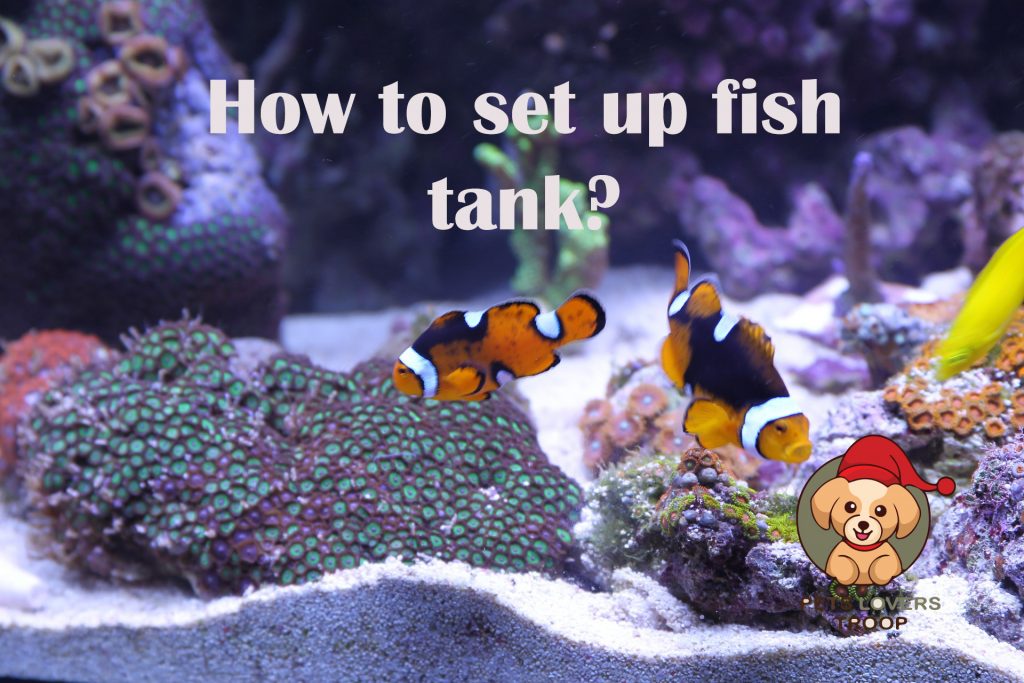
Are you planning to set up a fish tank at home? Looking for some tricks and tips to provide your fish with a safe and healthy environment? In search of strategies to clean your dirty fish tank? Well setting up a fish tank can be a fun and rewarding exercise; however, keeping it clean so your fish can survive and thrive requires utmost effort. Here are some steps that you can follow to set up a fish tank at your home:
Choose the right size and type of fish tank
The first step is to choose the right size and type of tank. Before buying a specific breed of fish, research the environment they dwell in. A rule of thumb is that your tank should be able to hold 1 gallon of water per inch of fish. Remember, never weigh your tank when it is empty. Ask the shop owner to fill the tank with water and substrate and then choose the right one depending on how many fishes you want to keep in it.

Different types of fish tanks are available in the market, including fish bowls and transparent tanks made of acrylic or glass and fish bowls. Ideally, choose a fish tank that is long and wide, as fishes mostly swim side to side. Also, the water’s surface facilitates gas exchange and supply of oxygen to fish so they can breathe. A more extended water surface area will allow the toxic gases to release properly and exchange oxygen. A wider space will enable them to swim and exercise as well as maintain the aquarium’s water quality.
Pick up the right location
After buying the fish tank, choose where you would like to place it on. For larger fish tanks, choose a permanent spot, as changing its position, again and again, can be a daunting task. Keep your fish tank away from direct sunlight. Like other plants, algae need sunlight to grow; hence, keeping the fish tank away from a window or a natural heat source is suggested. Ensure the spot is accessible and does not hinder maintenance and cleanliness activities.
Besides, only place the fish tank in an environment with little incoming noise from traffic, television, or speakers. Vibrations created by opening and closing doors can shock fish and, in some cases, be lethal. Choose a room where your fish tank is visible so you can quickly notice if it has any cracks or leaks. Also, ensure that the fish tank is placed closer to electric sockets so you can easily plug in the air pump, filter, or other electrical equipment. It is recommended that the socket should be to the side of the tank and not just behind it.
Install the filter
Installing a filter in the fish tank is not difficult, but there are some important points to remember while doing the job. Firstly, you need to understand that there are three stages of the filtration process in a fish tank: Biological (converts ammonia toxins into beneficial nitrites), chemical (removes harmful chemicals from water), and mechanical (removes debris from the bottom of the tank, including fish poop, solid waste, etc.).
The primary job of a filter is to remove harmful toxins and debris from the aquarium water and keep it safe and healthy for the fish. All filters come with handy instructions from the manufacturer, so ensure you read these thoroughly.
Replacing the filter can lead to the loss of beneficial bacteria vital for marine life. So you have two options: You can either replace the old filter medium with the new one and then add fresh water to the tank or remove the sponge from the old filter and insert a new one in its place.
It is suggested to place the new piece of sponge on top of the old sponge for at least two weeks before removing it. It will allow the beneficial bacteria to grow on the new sponge, causing no issues drawing out the older sponge.
Add substrate
Substrate refers to the loose material you add to your fish tank that usually settles on the bottom. It includes pebbles, gravel, sand, soil, and water-changing substrates. Substrates are typically added to the fish tank to enhance the overall aesthetic, provide a natural-looking environment, store beneficial bacteria, aid plants to survive, and help fish poop. Before adding the substrate, rinse them off thoroughly to remove any debris or dirt. At least add 3 inches of substrate in the fish tank, allowing ample space for the plant’s roots to grow without floating away.
Add decorations

Now add different decorations in the aquarium, including rocks, plants, ornaments, and driftwood. Decorations are essential to offer a naturally stimulating environment to the fish so they can feel comfortable and safe. It releases stress, allows them to hide in plants and behind rocks, and boosts their immune system. Besides stones and live plants, you can add a mist maker and decoration light to the aquarium.
Fill in the water
After adding ornaments, fill in your tank with fresh, dechlorinated water. Be careful with the temperature of the water before adding the fish to the tank. You can use a thermometer to check if the water’s temperature falls between 72-82°F (22-28°C) depending on the fish’s breed or type. Start adding a few fish first in the water, and over time add more. Ensure you search well about their dietary requirements or any other special care they might need to thrive.
Maintain the tank
After setting up the tank, regularly change its water, clean its filter and monitor the overall quality of the aquarium water. A dirty fish tank can lead to stress in your fish and, at times, can be lethal.
Understanding aquarium water
Understanding the aquarium’s water chemistry is vital for your fish to survive and thrive. Tap water has a different water chemistry, which makes it unfit for aquatic life, and hence it needs to be adjusted, treated, and maintained at a specific temperature. Fishes depend on aquarium water to obtain oxygen, eliminate waste, and absorb vital nutrients.
Read more: Step by step guide to set up a fish aquarium
PH is one of the most common adjustments to make in aquarium water. It measures the overall alkaline and acidity levels and ranges from 0 to 14, with seven being neutral. Anything below 7 is acidic, while anything above it is alkaline. Each fish has a different preference or range depending on their marine environment. For instance, wild lakes usually have more alkaline due to limestone reserves, while rivers such as Amazon are acidic due to soil and clay beddings or reserves.

Aquarium water has natural buffers that help in restoring the PH values to their original levels. To change the PH levels, you have to alter the water buffer levels with the help of a plant substrate. For instance, add a piece of wood to water and peat in the filter. Similarly, use substrates such as crushed coral to raise the PH levels for some specific fish breeds.
Remember that poor-quality aquarium water can build up harmful toxins, bacteria, and nitrites that can be lethal for the fish. Hence, as a fish pet, it is vital to perform regular water check-ups and keep a close eye on water quality. Also, treat water by adding a water conditioner to neutralize the harmful chemicals in tap water.
To maintain the consistent temperature of the aquarium water, use a heater, especially in aquariums with tropical fish or in colder regions. Filtration channels also help improve water quality and remove unwanted debris and waste. Try to change 20 to 25 percent of the fish tank’s water every two weeks to keep it fresh and clean for the fish.
How to clean a dirty fish tank?
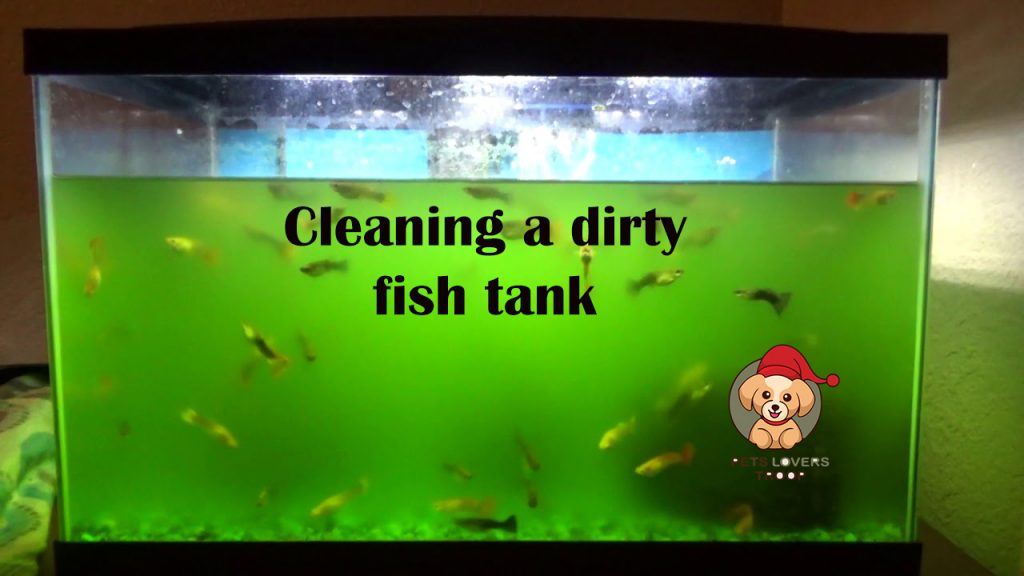
Fish tank cleaning is crucial for the overall well-being of your fish, as a dirty fish tank can shorten their lifespan. Here are some tips that can help you thoroughly clean the fish tank and maintain safe water conditions for your fish so they stay happy and healthy:
Step 1: Arrange the necessary equipment
Before starting tank cleaning, arrange all the needed equipment that, includes: a bucket, scraper, algae pad, razor blade, water conditioner, a sponge, a clean cloth or old towels, water siphon, glass cleaner, filter brush, and filter media. Remove and unplug all electrical equipment from the tank, such as a heater, filter, decorations, and plants. The cleaning order will be: Inside glass, decorations, gravel, outside glass/fixtures, and filter.
Step 2: Empty the water
Remove the old water from the tank with the help of a water siphon. Place one end of the hose in a bucket and the other in the fish tank, and use the suction produced to empty the tank. Siphon removes 25 to 30 percent of water or more if the tank is dirty.
Step 3: Start the cleaning process
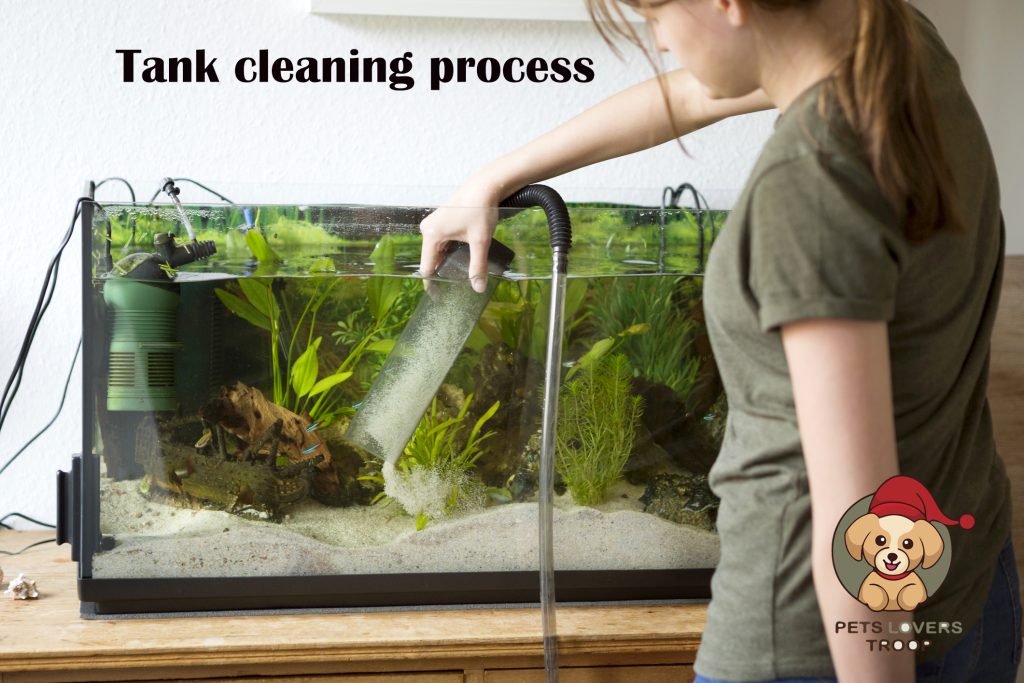
After removing water from the dirty fish tank, start cleaning the inside of the tank with the help of an algae pad. Buy them from a pet shop rather than the houseware store, as they contain chemical residue that can harm your fish. Use a razor blade to scrape off stubborn residue but take care that you do not cut yourself.
After cleaning the inside of the fish tank, now clean the rocks, decorations, and artificial plants. Notice if there is an algae build-up on them. Use a scrub and scraper soaked in warm water to remove all dirt and build-ups. For stubborn stains, make a special concentrated bleach solution (made up of 10 percent bleach only) and soak your decorations in it. Leave them for 15 minutes and then take them out, scrub them off, and rinse well in clean water. Let them air dry. Remember that stem plants cannot tolerate bleach; however, you can bleach live plants to remove stubborn marks or dirt.
Leave the rocks, decorations, and plants outside and vacuum the gravel thoroughly to remove the debris. Use a siphon hose to clean and suck all the waste or debris accumulated within the substrate. You can also use your hands to stir or move the gravel gently.
After cleaning the inside, now move to the outside glass. Clean the exterior glass, tank top, hood, and light. Use an aquarium-safe cleaner or vinegar solution to clean the outer surfaces but ensure you rinse the surface off with the help of a damp cloth.
Step 4: Refill the fish tank
The water removed due to the vacuum will now be replaced with dechlorinated water; however, ensure that the replacement water is at the same temperature as the extracted aquarium water. Before adding tap water to the tank, add a water conditioner to remove chlorine and other harmful chemicals. Slowly add the water to the tank, and remember to unplug the aquarium heater while changing the water.
Step 5: Reinstall the equipment
After refilling the fish tank, reinstall all the electric equipment, such as heaters and filters. Make sure that all the equipment is in working order.
Step 6: Clean the filter two weeks after the cleaning process
After two weeks, clean the filter. This waiting is to preserve the bacteria that reside within the filter media. The previous cleaning removed all the beneficial bacteria from the rocks, plants, and gravel, disturbing the ecosystem. All the beneficial bacteria that can kill toxins were already removed; hence changing the filter, the same day could release dangerous ammonia in the tank.
Also, gently rinse the medium that acts as a mechanical filter to remove debris, instead of replacing it. Do clean the filter tubing and all other parts of the filter with the help of a brush. Clean the filter every month by rinsing it off or completely replacing it.
How often do you clean a fish tank?
It depends on the number of fish you have and the size of your tank. Larger tanks require regular cleaning in comparison to smaller tanks. Clean your large tanks once every two weeks. Also, the more fish you have in your aquarium, the more waste they will excrete, leading to a build-up of harmful toxins. Some fish species cannot survive in poor water quality and need fresh water to thrive. Research and develop a cleaning schedule in accordance, and follow it religiously.
Read More: How often should I clean my aquarium?
Besides, it is recommended to perform water checks regularly. You can use a water testing kit to check the water’s ammonia, nitrite, and PH levels. Change 10 to 20 percent of the water every 1-2 weeks, and vacuum the substrate from the bottom to remove accumulated debris.
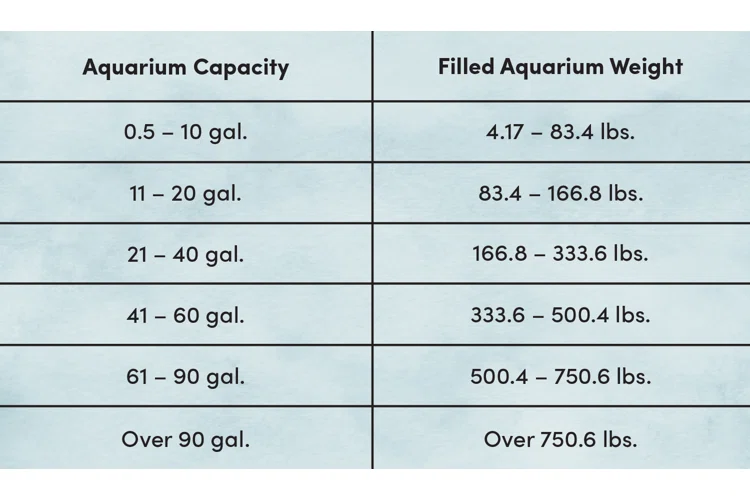
How to clean dirty fish tank with aquarium cleaner tools?
Do you ever wonder how to clean your dirty fish tank and remove all the uneaten food and fish poop? Well, aquarium cleaners are tools that can help you keep your aquarium clean and healthy. Here is a detailed guide to using aquarium cleaners:
- Switch off all the electric equipment, such as filters and heaters.
- With the help of a fish net, remove uneaten food and any excess debris from the water.
- Now with the help of a gravel vacuum, remove debris and waste at the surface of the aquarium. To use it, place it in the substrate and create a siphon with the help of a hand pump. Now move the vacuum around the substrate, but be careful and do not suck the plants or fish.
- Using an algae scrapper to clean the glass and remove algae build-up. Do not scarp the surface aggressively.
- Now take a sponge or brush to wipe off all rocks and decorations in the fish tank. With the help of a brush, thoroughly clean the filter media.
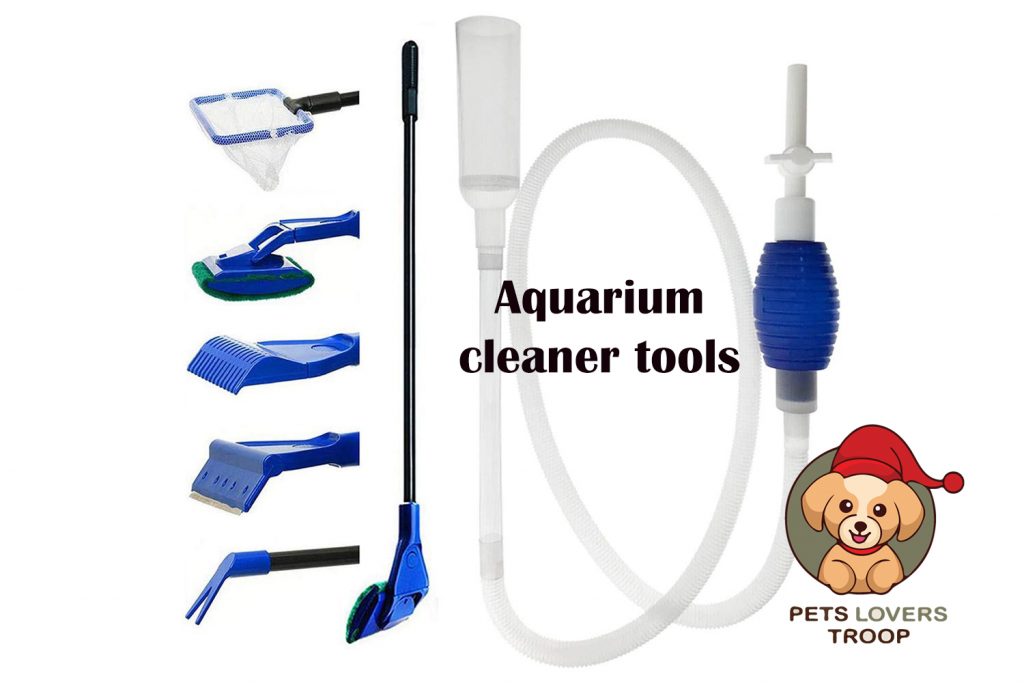
Can I use vinegar to clean a dirty fish tank?
Vinegar is a natural and safe product to clean your dirty fish tank. It’s readily available in the market and is quite popular among fish parents. To clean your dirty fish tank, take one part of vinegar and four parts of water solution. Dip a cloth or sponge in this solution and thoroughly clean the tank’s inside. After cleaning the dirty fish tank, rinse off the surface with clean water 4 to 5 times to remove any vinegar residue.
Before adding the fish to the tank, air dry the surface completely and avoid using towels or cloth to wipe off or dry the inside. It is important to note that vinegar should be used in moderation for cleaning a dirty fish tank. Only use it if you last washed your fish tank a while ago, or if it is heavily soiled.
How to Manage Fish Waste in an Aquarium?
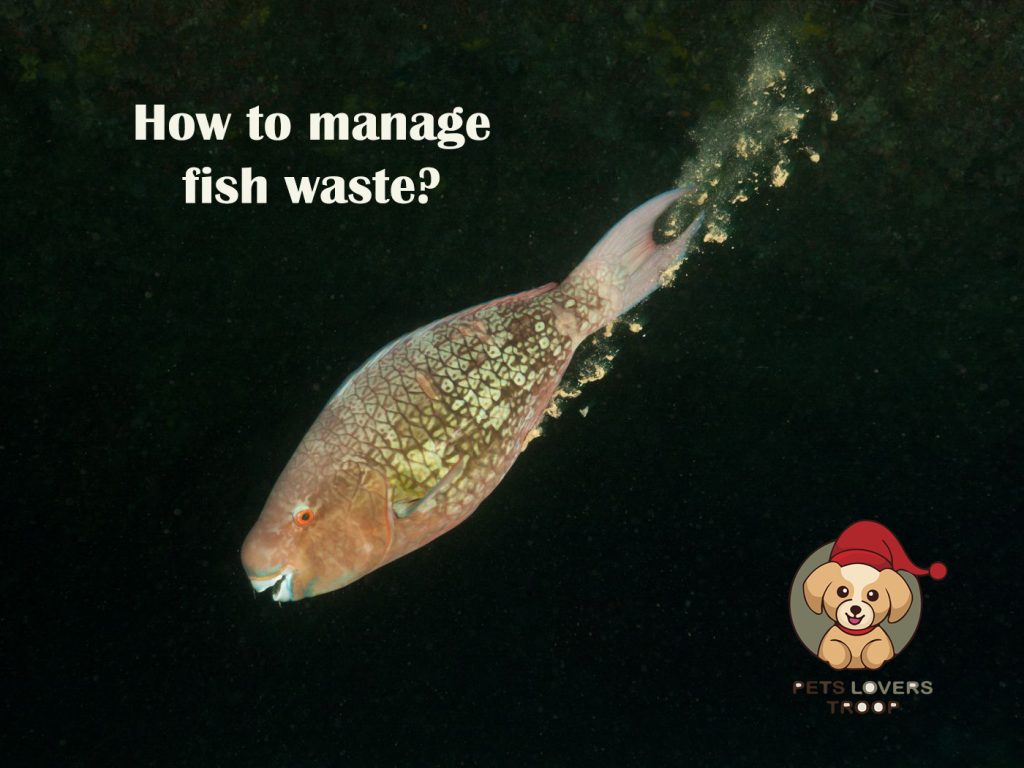
People often wonder: Do fish poop? Well, fishes, like all other living creatures, excrete waste materials. In fact, fish poop is an integral part of the overall aquatic ecosystem. Fish waste can be classified into two types: solid and dissolved waste. Solid waste is feces, which usually accumulates in the substrate, while dissolved waste is the ammonia produced by gills as they break down proteins.
Fish poop provides beneficial nutrients to marine plants and produces bacteria that convert the ammonia in the water into nitrites.
Read more: Do fish poop?
To clean fish waste from the tank, it is essential to clean the substrate. Also, changing the fish tank’s water regularly helps remove dissolved waste from a dirty fish tank. With the help of a siphon hose, you can easily extract debris from the bottom. Also, adding live plants can help improve the aquarium water quality and remove excess nutrients from the tank, maintaining a clean and healthy environment for your fish.
How to clean algae from a dirty fish tank?
Algae growth is a common problem fish owners face, which can be managed through regular cleaning and maintenance. Before starting the tank cleaning process, switch off all the electric equipment and prepare all the needed equipment, including an algae scrapper, siphon, etc. With the help of the scupper, carefully remove the algae from the tank. Start working from the top of the tank and move slowly to the bottom and sides. You can also use a razor blade to scrap off algae in the corners of the tank.
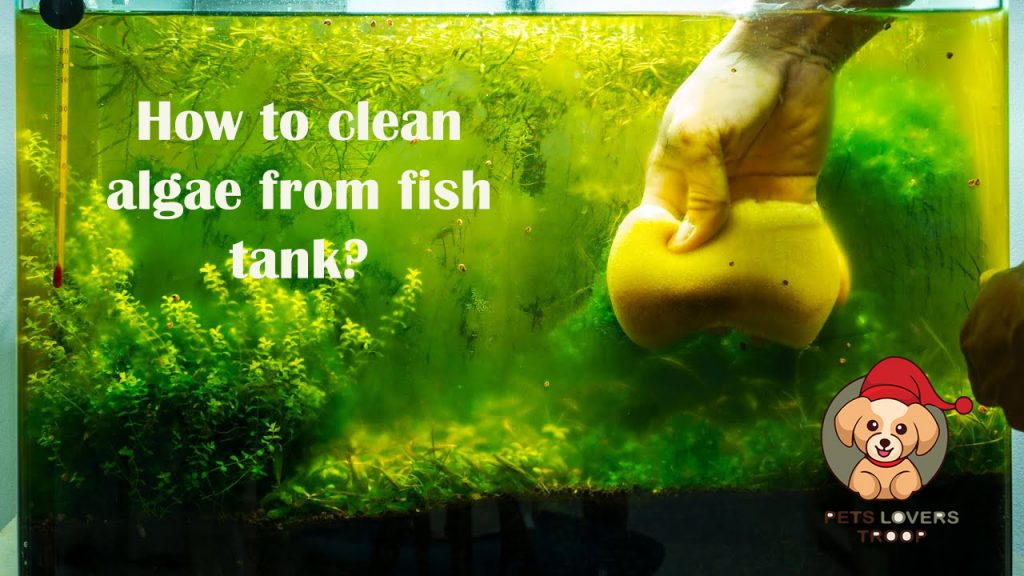
With the help of a siphon hose, vacuum the accumulated algae debris from the bottom of the tank. Also, remove all the decorations and clean them thoroughly to remove all algae residue. If you have any concerns about rapid algae growth in your fish tank, contact an aquarist for expert advice.
Why does my fish tank smell?
If your fish tank is smelling bad, immediately check all the possible causes that can lead to it and take instant action. Some of the most common reasons why your fish tank might be smelling include the following:
- Overfeeding fish
- Poor quality of aquarium water
- Lack of oxygen and aeration
- Dead plants or fish
- Dirt or accumulated debris in the bottom of the tank
- Unattended algae growth




